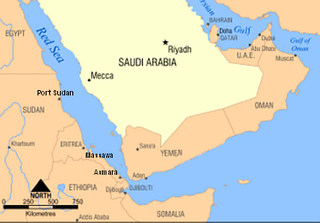
The British Mediterranean Fleet, also known as the Mediterranean Station, was a formation of the Royal Navy. The Fleet was one of the most prestigious commands in the navy for the majority of its history, defending the vital sea link between the United Kingdom and the majority of the British Empire in the Eastern Hemisphere. The first Commander-in-Chief for the Mediterranean Fleet was the appointment of General at Sea Robert Blake in September 1654. The Fleet was in existence until 1967.

The Red Sea Flotilla was part of the Regia Marina Italiana based at Massawa in the colony of Italian Eritrea, part of Italian East Africa. During World War II, the Red Sea Flotilla was active against the East Indies Station of the Royal Navy from the Italian declaration of war on 10 June 1940 until the fall of Massawa on 8 April 1941.
HMS Khartoum was a K-class destroyer of the Royal Navy, named after the capital of Sudan, Khartoum.

The Assistant Chief of the Naval Staff (A.C.N.S.) is a senior appointment in the Royal Navy usually a two-star rank and has a NATO ranking code of OF-7.
The Commodore-in-Charge, Algiers was an administrative shore based appointment of the British Royal Navy established during World war II who was responsible for the berthing of all British convoys in Algeria and its sub-commands, facilities and staff from 1942 to 1946. The post holder was based at Allied Force Headquarters, Algiers. It was at first a sub-command of the Commander-in-Chief, Mediterranean Fleet then later the Commander-in-Chief, Levant.

The Rear-Admiral, Alexandria was an administrative shore based appointment of the British Royal Navy. The post was established during the Second World War, subordinate to the Commander-in-Chief, Mediterranean Fleet then later the Commander-in-Chief, Levant.

During the First World War, the Commander-in-Chief at the Cape, Rear Admiral Herbert King-Hall, expended much effort to destroy the elusive German light cruiser Königsberg.
Brighlingsea Naval Base was an installation of the British Royal Navy located at Brightlingsea, Essex, on the East Coast of England. In both wars it was part of the Nore Command, which had its HQ at Chatham, and in the Second was part of Harwich Sub-Command. It existed from late 1914 to 1921, and from early 1940 to 1947,
The Flag Officer-in-Charge, Humber was a Royal Navy officer who administered naval forces located at Immingham and Grimsby, Lincolnshire, England. His formation was sometimes known as the Humber Station or Humber Area. In World War I it was a sub-command of the Admiral of Patrols from 1914 to 1916, then came under the Commander-in-Chief at the Nore until 1921. In World War II the FOIC was responsible to the Commander-in-Chief, The Nore.

The British 5th Destroyer Flotilla, or Fifth Destroyer Flotilla, was a naval formation of the Royal Navy from 1910 to 1942 and again from 1947 to 1951.
The Senior Naval Officer, Persian Gulf, was a Royal Navy command appointment who was responsible for administering the Persian Gulf Station military formation including its establishments and naval forces known as the Persian Gulf Squadron later called the Persian Gulf Division. Initially located at Basidu, Qishm Island, in Persia, then Henjam Island in Persia (1911–1935), and finally Ras Al-Jufair, Bahrain (1935–1972).
The British 11th Destroyer Flotilla, or Eleventh Destroyer Flotilla, was a naval formation of the Royal Navy from August 1915 to September 1945.
The British 12th Destroyer Flotilla, or Twelfth Destroyer Flotilla, was a naval formation of the Royal Navy from November 1915 to March 1919 and again from September 1939 to 2 July 1943.
The14th Destroyer Flotilla, or Fourteenth Destroyer Flotilla, was a naval formation of the British Royal Navy from April 1916 to 11 February 1919 and again from 1 June 1940 to January 1944.

The Naval Officer-in-Charge, Aden, was an administrative appointment of British Royal Navy originally established in 1839 as the Senior Naval Officer, Aden. He was responsible for HMS Sheba. It was a sub-command of the Flag Officer, Middle East.

In the Royal Navy, a principal naval transport officer (P.N.T.O.) later known as principal sea transport officer (P.S.T.O.) is a shore-based flag officer or captain responsible for sea transport duties, and assisting the senior naval officer's area of command in the preparation of naval orders and conduct disembarkations. British Dominion Navies also used the concept.
The Senior British Naval Officer, Suez Canal Area was an administrative appointment of the Royal Navy established during World war II who was responsible for the naval base HMS Stag at Ismailia, Egypt. The SBNO was subordinate to the East Indies Station from 1939 to 1941 then the Mediterranean Fleet until 1942.

The Black Sea and Caspian Squadron, also known as the Black Sea and Marmora Force and the Black Sea and Marmora Division, was a naval formation of the British Mediterranean Fleet from 1918 to 1919.
James Murray Pakenham Pipon KBE CMG MVO was a Royal Navy officer who served in World War I and, after being recalled to active duty in 1940, World War II.




